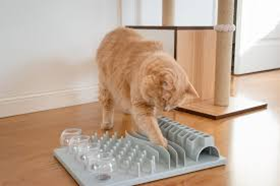Going Home Guide For Your Maine Coon Kitten
- gritif92
- Sep 22
- 6 min read
Congratulations on welcoming a Maine Coon kitten into your home! These majestic, fluffy giants-in-the-making are known for their sociable personalities, intelligence, and impressive size—often reaching 15-30 pounds as adults. As a new owner, your first weeks together are crucial for building trust, supporting healthy growth, and preventing common issues like matting fur or overgrown claws. This guide covers essential setup items and tips, with rationales tailored to the breed’s needs: high-energy play, long double coats, and rapid early development. Focus on quality over quantity to set your kitten up for a long, happy life.
1. Preparing Your Home: Essentials for Safety and Comfort
Before pickup day, kitten-proof your space. Maine Coon kittens are curious explorers who love high perches, so secure cords, close cabinets, and provide safe climbing spots.
Carrier for Transport: Use a sturdy, well-ventilated hard-sided carrier lined with a soft blanket. The bumpy car ride home can be stressful; a familiar-scented carrier reduces anxiety and prevents escapes. Opt for one large enough for their adult size (at least 24x16x16 inches) to avoid feeling cramped during vet trips.

Stainless steel litter pan Litter Box Setup: Choose an open-top box (no hoods) with low sides, preferably stainless steel to minimize bacteria and odor trapping, and filled with unscented, clumping litter like Tidy Cat light weight. The fine particles don’t tend to get wedged between toe beans and pads as easily. Place the litter box in a quiet, accessible spot. Maine Coon kittens have big paws and bodies even as babies, so a spacious box (at least 22x18 inches) accommodates their growth and encourages proper elimination habits, reducing litter box aversion and unwanted elimination on floors. Dr. Elsey’s kitten litter attract is great for guiding kittens to use the litter box and some is included in your gift bag. Sprinkle this on top of your regular litter.
Cozy Bedding: A plush, washable cat bed or cat tree in a quiet corner. While beds are nice to have, Maine Coons like to stay close to or lay on their owners so I wouldn’t worry too much about cat beds. Cat trees are a must to save your furniture.
2. Nutrition: Fueling Growth with the Right Food

Maine Coon kittens grow rapidly (up to 8 pounds in the first year), needing nutrient-dense meals to support lean muscle without excess weight gain. Kitten dry food should always be available to them and transition gradually from the breeder's food in 25% portion combinations till switched. Wet food such as instinct is given at least once daily while raised at the breeders but the protein and fat content is significantly lower than dry food.
Quality High-Protein, Moderate-Fat Kitten Food Brands: Recommended options include Nulo, Instinct (dry or wet), Orijen Kitten, Wellness Core Kitten Formula, and Acana First Feast Kitten. Aim for formulas with 40-50% protein and 15-20% fat on a dry matter basis. As obligate carnivores, Maine Coons thrive on animal-based proteins for coat health, energy, and joint support—key for their large frames. Moderate fat prevents obesity in less active indoor cats, while low carbs mimic their ancestral prey diet. Supplement with wet food (e.g., Instinct or Tiki Cat) for hydration.
Feeding Tip: Use puzzle feeders that dispense meals encourages natural foraging instincts, slows rapid eating (common in food-motivated Maine Coons), and provides mental stimulation to prevent boredom-induced mischief.

Puzzle feeding tray
3. Grooming Tips: Maintaining That Signature Fluff
Maine Coons have water-resistant double coats that shed seasonally and mat if neglected. Start gentle handling early to make grooming a bonding ritual. Start slowly with only a minute of gentle brushing to get them accommodated then slowly increasing in length of time.
Weekly Brushing: Use a slicker brush or Furminator for 5-10 minutes, focusing on the belly, armpits, and tail. Removes loose undercoat to prevent painful mats, distributes natural oils for shine, and reduces hairballs—a bigger issue for their voluminous fur. Early habituation builds trust.
Bathing (If needed): Only if they get dirty; use a cat-specific shampoo like Earthbath. Their coat repels dirt, but occasional baths keep it clean without stripping oils, supporting skin health in this allergy-prone breed.
Ear and Dental Care: If you notice a buildup than wipe ears with a warm wet cloth. Furry ears trap debris, risking infections; dental treats or toys like silver vine helps prevent periodontal disease.

Silvervine cat sticks
4. Nail Care: LED Nail Trimmers
Invest in LED-lit nail clippers with built-in lights.
Usage: Trim every 14-30 days, clipping just the clear tip (avoid the pink quick). Reward with treats after each session. Maine Coons have thick, fast-growing nails that can snag furniture or scratch skin if unchecked. The LED light illuminates the quick for safer, stress-free trims, preventing accidental cuts that could make your kitten paw-shy. A good way to accomplish this is to wrap the kitten up in a blanket burrito or swaddle similar to a newborn. Gently pull each arm out as you trim their nails and brace my hand above their elbow to prevent pulling back. This becomes easier with practice or a helper. Several you tube videos can be found on how to do this with different techniques.

LED cat nail trimmer
5. Hydration: Stainless Steel Water Fountain
A circulating fountain like the PetSafe Drinkwell or Catit Flower Fountain (stainless steel model) is a must. Maine Coons have a high water demand similar to dogs and need the hydration to prevent UTI or urinary crystals.

Setup: Place near food but not in the litter area; clean weekly and as needed. Maine Coons have a tendency to play in, paw at water and even will drop their food in bowls and fountains. You may want to consider putting a rubber mat or plastic catch tray underneath the fountain to prevent water damage to flooring. Running water is a known fascination with Maine coons, they often prefer fresh sources, mimicking streams. Stainless steel resists bacteria buildup better than plastic, promoting urinary health in large breeds susceptible to crystals from dehydration.
6. Scratching and Enrichment: Scratching Posts
Provide a tall sisal or carpet scratching post, the more the better. You will have little to no issue with scratched furniture if posts and floor cardboard scratchers are provided
Placement: Near sleeping and play areas; offer multiple as they grow. Instinctual scratching maintains claw health, marks territory, and stretches muscles for their agile, tree-climbing heritage. Sturdy, tall posts (at least 32 inches) suit their size, deterring furniture damage and providing vertical space in your home.
Interactive Toys: Wand toys, carboard boxes, hair scrunchies and puzzle balls. Often the least expensive the more long term fascination. High-energy Maine Coons need 40 minutes of daily play as kittens to burn calories and prevent destructive behavior; these mimic hunting, fostering mental sharpness and bonding.
7. Health and Vet Essentials
Schedule a vet check within 72 hours of arrival.
Spay/Neuter Planning: Consider scheduling with the vet around 7-9 months. It is now recommended that the kittens be able to experience the hormone growth benefits before being fixed. If you’re interested in a detailed explanation of the benefits in development then you can check out the blog on our website. In general, it is now believed to allow for stronger bones decreasing fractures and hip/joint issues, helps with male ureter and urethral growth thereby decreasing urinary tract issues, some cancers, or endocrine strain.
Spay/neuter prevents unwanted litters, male spraying and “stud tail,” pyometra in females and curbing calling or roaming urges in this friendly breed.
Final Tips for Success: Bonding
It doesn't happen overnight. American animal psychologists always warn new cat owners about the 3-3-3 Rule
3 Days: This is a general guideline for the adaptation period of a cat or kitten after adoption. Please be patient and give your Maine Coon kitten time to adapt to their new family. It takes 3 days to move on from the stress state when transferring in vehicles to a new environment. They may feel sad, frightened, depressed about not being around familiar pets and surroundings. May not want to eat or drink and will hide under furniture till the new home and sounds become familiar.
3 Weeks: It takes this long to learn new daily routine. The kitten will begin to settle in, feel more comfortable, and understand that this is their forever home. They now understand and recognize the environment and surroundings as familiar and gets into the rhythm of their family life. This is often when the kittens true character, personality and quirks will start to come out.
3 Months: The kitten now feels at home and feels safe and comfortable while the bond to his new owner has solidified.
Patience is key—these "gentle giants" bond deeply but take time to adjust. If issues arise, consult with breeder for recommendations or a veterinarian for health issues. Your Maine Coon will reward you with years of purrs, headbutts, and endless entertainment. Enjoy the adventure! If you need breed-specific product links, just ask.




Comments